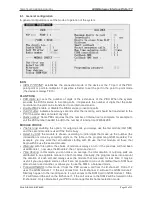
TEMA TELECOMUNICAZIONI SRL
GSM Gateway Interface DIAL-112
MAS-DIAL112-REV06EN
Page 7 of 35
2. CHARACTERISTICS OF DIAL-112
DIAL-112 main features are
•
1-2 bult-in GSM quad-band (850/900/1800/1900 MHz) engines
•
Compatible with 1.8V to 3V SIM CARD
•
DISA service for PBX’s direct internal selection
•
T0 BRI Euro-ISDN Point-to-Point or Point-to-Multipoint Connection
•
USB Connection for PC programming, without dedicated software
•
Programmable via local phone or remotely, via DTMF tones
•
Loudness setting in TX/RX independently on both GSM channels
•
Flexible and optimized management of the system’s SIM cards
•
LED indications of system status
•
Save / restore of all system parameters in / from a file backup archive
•
System configuration file saving on a plain text file for archive or verify
Services for outbound calls (converted from the wired line network to GSM)
DIAL-112 allows making direct calls to cellular telephones using the GSM network, which is
more cost-effective than calling from a wired line. Moreover:
•
Call by call conversation timeout with time recharge option
•
Table for inhibiting outbound calls to complete unwanted numbers or to unwanted prefixes,
possibility to inhibite all the outbound calls, so all inbound calls will be privileged.
•
Possibility of SIM identity hiding of the GSM modules to the called number
•
Possibility of counting minutes of traffic for outgoing calls, with the possible blocking of
outgoing calls following to the end of credit or sending SMS text alerts
•
Access to the module for local programming via DTMF
Services for inbound calls (converted from GSM to wired line)
DIAL-112 receives calls from the GSM network and reroutes them to the PBX (or telephone) in
wired line ISDN mode. Moreover:
•
Possibility of rejecting all incoming calls or anonymous incoming calls
•
Table for inhibiting unwanted callers (rejecting incoming calls)
•
Sending the caller-ID (CLI) to the downstream ISDN device
•
No timeout on incoming calls
•
Access to the remote programming via DTMF
Additional functions
•
Smart callback: for the automated diversion of the call back to the PBX’s internal
extension (outgoing calls)
•
SMS callback: similar to the previous service, the caller that have not reply or is busy will
receive a SMS with predefined text
•
GSM module selection: depending on the chosen B channel of the ISDN BRI line
•
Alarm contacts: 2 contacts of external input for Alarm / Remote Notification service via
SMS
•
Output contacts: 2 internal relays contact for remote control of low power devices, in
impulse or stable mode (future implementation)
•
CLI-based automatic routing service: Service to automatically route the caller based on
his CLI to an internal extension target








































